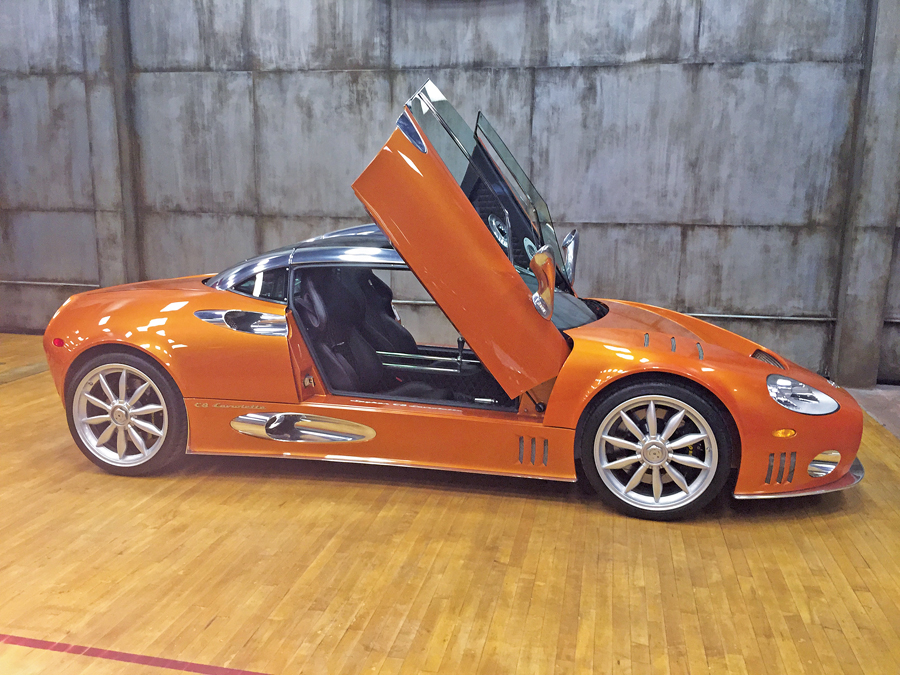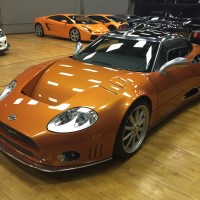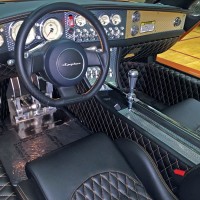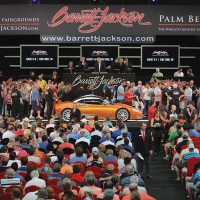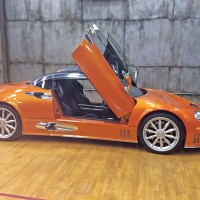SCM Analysis
Detailing
| Vehicle: | 2009 Spyker C8 Laviolette |
| Number Produced: | An estimated 310 Spykers (two different models) were built |
| SCM Valuation: | $175,000–$200,000 |
| Tune Up Cost: | $750 |
| Chassis Number Location: | Plate inside windshield on dashboard on lower left hand side |
| Engine Number Location: | Front of the engine on top of the cylinder block |
| Alternatives: | 1994 Bugatti EB110, 2005 Ford GT, 2001 BMW Z8 |
| Investment Grade: | C |
This car, Lot 409, sold for $220,000, including buyer’s premium, at the Barrett-Jackson West Palm Beach, FL, auction on April 18, 2015.
The resurrection of dead marques is a tricky business. There are a host of considerations to ponder, ranging from “Will anyone remember what made this brand great?” to “Will the car have anything in common with what came before except a badge?” to “Will we offend generations of devoted marque followers?” to “Will anyone actually care?”
When the brand is Bugatti or Maybach, Isotta Fraschini or Packard, these questions loom quite large. On the other hand, please stand up if you have ever heard of Spyker.
Anyone who regularly attends the Pebble Beach Concours d’Elegance or has visited the Louwman Museum in The Hague can excuse himself — or herself — from the quiz.
A blast from the distant past
For the rest of you, Spyker is a very old name, as the Netherlands-based company built its first vehicle in 1898. The brothers Spijker, coachbuilders and repairers, constructed a motor carriage powered by a Benz engine. They continued in the coach business, however, building a state coach for Dutch Queen Wilhelmina in 1901 that is still used for high ceremonial occasions.
Their 60-hp Grand Prix racer of 1903 holds the distinction of being the first 6-cylinder, four-wheel-drive car, quite a stretch indeed for a factory that built its first car only five years before. A second place in the 1907 Peking to Paris race cemented Spyker’s reputation for performance and durability. Although the Spyker C4 broke an average speed record in 1922, by 1925 the company was out of business.
In 2000, the name was revived to launch a line of sports GT cars for which a brand connection would be made with the race and record cars of the original company. Like the stillborn, late-1990s effort to revive Isotta, Audi featured in the mechanical specification of the new Spyker. The 400-hp Audi V8 gave the C8 the capability of a 0–62 mph time of 4.5 seconds on the way to a 168-mph top speed.
As the original Spyker company was involved in aircraft production, the design of the C8 leaned heavily towards aviation themes, such as chromed air scoops and vents along with a plethora of machine-turned and polished alloy bits, including visible shift linkage. Combined with more quilted cowhide than normally seen outside of a European handbag store, the effect is stunning — but certainly not subtle.
A 5th-place finish at Le Mans in 2009
Racing improves — if not proves — the brand, and Spyker indeed did work to make a mark in contemporary competition. The C8 Double 12R debuted at Sebring in 2002 but failed to finish. Subsequent entries were made at Le Mans, where the C8 Spyder GT2R achieved an impressive 5th place overall finish in the 24 Hours in 2009.
The company also branched out into Formula One in 2006, buying the Midland F1 team, the former Jordan Grand Prix outfit. The team scored a championship point at the 2007 Japanese Grand Prix due to a place upgrade thanks to a penalty. But — not surprisingly — financial issues forced a sale to Vijay Mallya at the end of the season, at which time the team became Force India.
Rare for sure — but how valuable?
About Spyker’s purchase of Saab from GM in 2010, the less said the better. Since its start in 2000, the company has built just over 300 cars. So any Spyker is certainly rare.
As an orphan, how does the Spyker C8 compare to another notable car from the resurrection wilderness — the Bugatti EB110? As a “modern classic” how does it compare to a Ford GT, BMW Z8 or McLaren F1?
The McLaren comparative is not as wild as it might seem. Unlike the Ford, BMW or for that matter, Koenigsegg, Spyker did indeed take their car to the racetrack — and with some success. The EB110’s one outing at Le Mans in 1994 went well, but the car failed to finish, so Spyker is one up on that as well. Only the McLaren F1’s record in competition is better, but that’s no surprise.
Of the nine U.S. dealers listed on the Spyker website, only two, Spyker of South Florida in Pembroke Pines and Miami, FL, and Blue Grass Motorsport in Nashville, KY, seem to have an active website for Spyker cars. Of those two dealers, only South Florida lists any inventory: six pre-owned cars in stock. One of those appears to have been this very vehicle.
It’s worth noting that all those used cars have the “Quilted Leather Package” which seems to be the point of the interior, so it’s hard to imagine a Spyker without it. It’s not possible to find new cars, as the company entered bankruptcy in December 2014. While the bankruptcy was overturned in early 2015, Spyker has yet to make their next move or reorganization.
Not a blue-chip collectible
Ultimately, I think the cars are likely to remain a curiosity rather than a source of great future appreciation. Although, like the Ferrari Testarossa and Lamborghini Countach, at some point their almost post-modern extreme detailing will mark them as the quintessential motoring version of the oversized multi-complication-wristwatch-as-fashion-accessory that began appearing in 2000.
Although it had barely any mileage at all, our subject still brought nearly its original MSRP after six years, which isn’t tragic.
At the time of this writing, a dealer in the Netherlands has two cars on offer, a 2005 C8 Spyder with approximately 23k miles for $203,500 and a 2011 C8 Aileron with just over 10k miles at $328,900. Both prices are near MSRP but would probably be unattainable in the United States.
For the extrovert seeking a dramatic fashion statement for his local Cars & Coffee — while retaining the ease of service of a Q5 — a Spyker might not be a bad choice. ♦
(Introductory description courtesy of Barrett-Jackson.)
